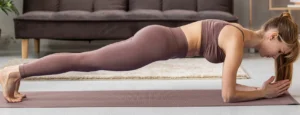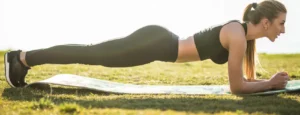The Plank Ups exercise is a fantastic bodyweight exercise that targets multiple muscle groups and can be easily incorporated into a busy lifestyle. This exercise does not require any special equipment and can be performed nearly anywhere, making it ideal for individuals with limited time and space.
When performing Plank Ups, you primarily engage your core muscles, including the rectus abdominis, transverse abdominis, and obliques. These muscles play a crucial role in maintaining stability, improving posture, and supporting your spine. By regularly including Plank Ups in your workout routine, you can strengthen and tone your core, leading to improved overall core strength and stability.
In addition to the core muscles, Plank Ups also engage your upper body muscles, including the shoulders, arms, and chest. As you move from the plank position to the high plank position, you activate the muscles in your shoulders and arms to support your body weight. This exercise can effectively tone and strengthen these upper body muscles, contributing to improved muscle definition and upper body strength.
Plank Ups also require coordination and control, as you transition between the plank and high plank positions. This movement challenges your body’s stability and requires proper body alignment and control. By practicing Plank Ups regularly, you can enhance your coordination skills and body awareness, which can be beneficial in various daily activities and sports.
The Plank Ups exercise also activates the muscles in your lower body, including the glutes, quadriceps, and hamstrings. These muscles provide support and stability during the movement, helping you maintain a proper plank position. While the primary focus is on the core and upper body, the lower body muscles are still engaged, leading to improved overall strength and muscle activation.
Another advantage of Plank Ups is its ability to increase heart rate and provide cardiovascular benefits. This exercise can be performed in a continuous and controlled manner, creating a challenging cardiovascular workout. By incorporating Plank Ups into your routine, you can improve your cardiovascular endurance, which is essential for overall fitness and stamina.
Lastly, one of the great benefits of Plank Ups is its accessibility and convenience. You can perform this exercise anywhere, whether at home, in the office, or while traveling. It requires minimal space and no equipment, making it a time-efficient and practical option for busy individuals.
Plank Ups – Instructions & Steps
- Start in a plank position with your forearms on the ground.
- Tighten your core, and push your core upward, arching your back.
- Release and lower your core to the ground as if you were doing a push up.
- Repeat
Benefits of Plank Ups
Plank Ups is a versatile exercise that offers numerous benefits for individuals looking to improve their fitness level and overall well-being. This exercise can be performed without the need for special equipment and is suitable for people with busy schedules. By incorporating Plank Ups into your routine, you can target multiple muscle groups, enhance core strength, improve stability, and boost cardiovascular endurance. Here are some of the key benefits of Plank Ups:
Core Strengthening
Plank Ups engage the core muscles, including the rectus abdominis, transverse abdominis, and obliques. By regularly performing this exercise, you can strengthen and tone your core, leading to improved stability, better posture, and reduced risk of lower back pain.
Upper Body Toning
Plank Ups activate the muscles in the shoulders, arms, and chest. As you transition between the plank and high plank positions, you challenge and strengthen these upper body muscles. With consistent practice, you can achieve better muscle definition, increased upper body strength, and improved overall upper body appearance.
Improved Coordination
Plank Ups require coordination and control as you move between different positions. By practicing this exercise, you can enhance your coordination skills and body awareness, which can have a positive impact on your daily activities and sports performance.
Lower Body Activation
While the primary focus of Plank Ups is on the core and upper body, the exercise also engages the muscles in your lower body, including the glutes, quadriceps, and hamstrings. This activation leads to improved overall strength and stability in the lower body.
Cardiovascular Endurance
Plank Ups can elevate your heart rate and provide cardiovascular benefits. Performing this exercise in a continuous and controlled manner can contribute to improving your cardiovascular endurance, which is crucial for overall fitness and stamina.
Time Efficiency
Plank Ups are a time-efficient exercise option, as they can be performed quickly and effectively. With no special equipment required, you can easily fit this exercise into your busy schedule, whether at home, in the office, or while traveling.
Versatility and Convenience
One of the great advantages of Plank Ups is their accessibility and convenience. You can perform this exercise nearly anywhere, making it a practical choice for busy individuals. It requires minimal space and can be done without any special gym equipment, allowing you to maintain your fitness routine wherever you are.
More About Plank Ups
Plank ups, also known as plank to push-up, is a challenging compound exercise that combines elements of a plank and a push-up. This exercise is excellent for building upper body and core strength.
To perform plank ups, start in a plank position with your elbows on the ground and your body in a straight line. Push up onto your hands, one hand at a time, until you are in a push-up position. Then, lower yourself back down onto your elbows, one arm at a time, to return to the plank position.
- Chest (Pectorals): The pushing motion engages your chest muscles, helping to build strength and definition in the pectorals.
- Shoulders (Deltoids): Plank ups require shoulder stability and activation of the deltoid muscles during the pushing and stabilizing phases.
- Triceps: The triceps are heavily engaged during the push-up portion of the exercise.
- Core (Abdominals and Lower Back): Your core muscles work hard to stabilize your body and maintain proper form throughout the movement.
Plank ups are a compound exercise that primarily works the chest (pectoral muscles), shoulders (deltoids), and triceps. It also engages the core muscles, including the abdominals and lower back, to stabilize the body throughout the movement.
This exercise is an effective way to build upper body strength, especially in the chest, shoulders, and triceps. It also helps improve core stability and endurance. However, plank ups require proper form and strength to perform correctly, and they may not be suitable for beginners or those with shoulder or wrist issues. If you’re new to this exercise, it’s a good idea to start with standard planks and push-ups before attempting plank ups.



